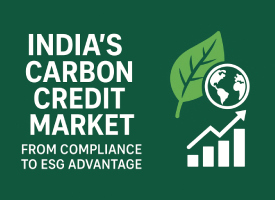By Apalka Bareja and Aishwarya Rajput
Introduction: A Climate and Business Turning Point
In 2023, India accounted for over 7% of global CO₂ emissions, making it the world’s third-largest emitter [1]. The same year, record-breaking heatwaves pushed peak electricity demand above 250 GW, exposing the country’s energy vulnerabilities.[2] Meanwhile, Indian exporters brace for the EU’s Carbon Border Adjustment Mechanism (CBAM), which from 2026 will impose tariffs on carbon-intensive imports like steel and cement.[3]
Against this backdrop, India’s Carbon Credit Trading Scheme (CCTS) is more than a climate policy; it is a survival strategy. Introduced under the Energy Conservation (Amendment) Act, 2022, the CCTS will be fully operational by 2026, rewarding industries that cut emissions and creating a market for those that lag behind. [4]
Understanding Carbon Credits
Carbon trading is essentially a market system to control emissions.
Companies are given targets for how much greenhouse gas (GHG) they can emit. If a company reduces emissions below its target, it earns carbon credits (with one credit equal to one ton of CO₂ reduced). These credits can then be sold to other companies that exceed their limits. In this way, efficient companies generate revenue by selling surplus credits, while higher-emitting companies must buy credits or face penalties. The system creates a financial incentive to cut emissions and encourages investment in cleaner technologies, making sustainability both an environmental and economic opportunity.
The CCTS Framework: How It Works
- Carbon Credit Certificates (CCCs): 1 ton of CO₂ reduced = 1 tradeable certificate.
- Compliance Market:Large industrial firms must meet emission targets or buy credits.
- Voluntary Market:Non-obligated companies can participate to improve ESG ratings.
- Oversight:Managed by the Bureau of Energy Efficiency (BEE), monitored by state agencies, and traded on platforms like the Indian Energy Exchange (IEX).
- Current Status:In 2025, the government set emission intensity targets for over 130 large companies, including UltraTech Cement, Hindalco, and JSW Steel.[5]
In April 2025, the government set Greenhouse Gas Emission Intensity (GEI) targets for 130+ large industrial entities, including UltraTech Cement, Hindalco, and JSW Steel—signaling the seriousness of compliance enforcement[6].
Legal and Regulatory Context: Navigating Compliance
| ASPECT | DETAILS |
| Statutory Basis | Carbon Credit Trading Scheme (CCTS) introduced under the Energy Conservation (Amendment) Act, 2022[7], empowering the government to issue and regulate Carbon Credit Certificates (CCCs). |
| Regulatory Institutions | – Bureau of Energy Efficiency (BEE): Administrator; responsible for MRV (Monitoring, Reporting, Verification).
– Central Electricity Regulatory Commission (CERC): Oversees trading on exchanges. – Grid Controller of India: Maintains national carbon registry. – National Designated Authority (2025): Aligns Indian carbon market with Paris Agreement (Article 6). |
| Compliance & Enforcement | Companies failing to meet emission intensity targets risk penalties under the Environment (Protection) Act, 1986. Non-compliance may restrict access to credits and attract regulatory scrutiny. |
| Disclosure & Greenwashing Risks | Listed companies must align carbon reporting with SEBI’s BRSR. False or exaggerated claims could trigger action under SEBI’s anti-greenwashing rules and the Consumer Protection Act, 2019. |
Challenges: What Could Hold India Back?
| Challenge | Risk | ESG Dimension Affected |
| Weak MRV (Monitoring, Reporting & Verification) | Inaccurate reporting may lead to greenwashing allegations and reduced market confidence | Environmental, Governance |
| Regulatory Uncertainty | Frequent or unclear policy changes can discourage long-term investment and create compliance confusion | Governance |
| Low Market Liquidity | Insufficient trading volumes may result in volatile carbon prices, reducing participation and stability | Environmental, Governance |
| Credit Integrity | Risks of double counting, poor-quality offsets, or unverified credits undermine credibility of the system | Environmental, Social |
| Stakeholder Exclusion | Failure to involve local communities may erode trust and social legitimacy, limiting project acceptance | Social |
Opportunities: ESG Value Beyond Compliance
- Revenue from Surplus Credits: Companies exceeding targets can monetize extra credits. For example, energy-efficient cement manufacturers could sell CCCs to less efficient peers.
- Improved ESG Rating: Verified carbon reductions enhanceenvironmental (E) scores and strengthen investor appeal. Studies show companies with strong ESG credentials enjoy lower capital costs.[8]
- Social and Community Benefits: Projects linking carbon reduction with rural electrification, job creation, or health initiatives reinforce thesocial (S) pillar of ESG, ensuring co-benefits beyond carbon savings.
- Governance Leadership: By embedding carbon accounting, disclosure, and ESG-linked executive accountability, firms can turngovernance (G) into a competitive edge.
Conclusion: Compliance or Global ESG Benchmark?
India’s carbon market stands at a decisive inflection point. It can remain a compliance-driven mechanism, where companies trade credits simply to satisfy minimum legal requirements, or it can evolve into a transformational framework that drives ESG leadership, attracts sustainable capital, and strengthens global competitiveness.
The establishment of the National Designated Authority in 2025 to align India’s market with the Paris Agreement is a significant step forward. Yet, the true success of the Carbon Credit Trading Scheme (CCTS) will hinge on regulatory stability, robust monitoring and verification systems, and active participation across industries.
The next five years will be critical. If implemented effectively, CCTS can shift India’s carbon market from being perceived as a bureaucratic obligation to being recognized as a strategic tool that positions India as a global ESG pioneer—one that not only advances national climate goals but also reshapes the way Indian businesses compete and grow in the low-carbon economy.
[1] https://www.iea.org/reports/co2-emissions-in-2023/the-changing-landscape-of-global-emissions#
[3] https://www.ft.com/content/6f324116-2707-440d-8808-c98749f8bc87
[8] https://esgnews.com/msci-study-finds-higher-esg-ratings-lower-cost-of-capital-for-companies/


